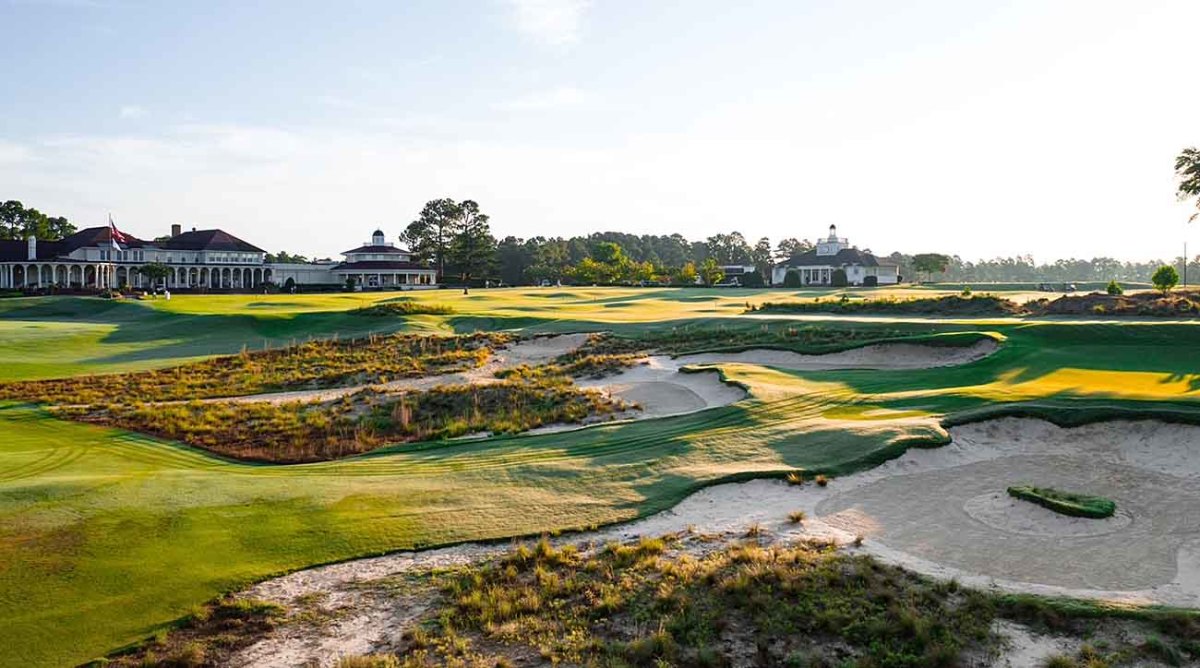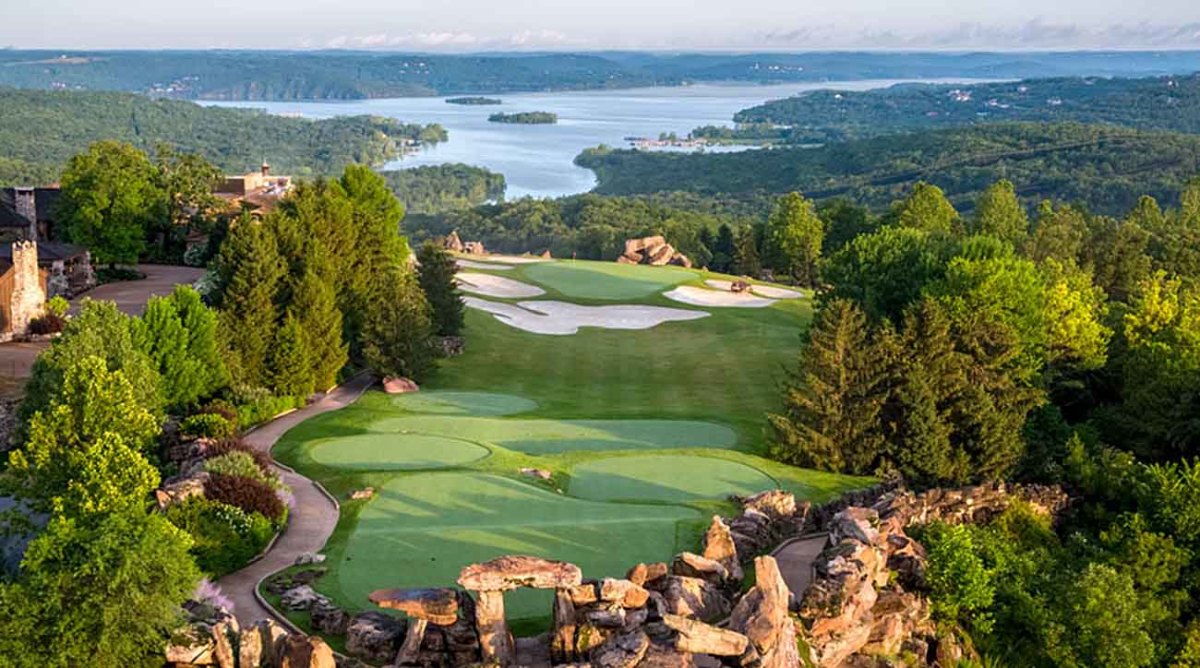Long on Memories If Not Yards, Golf's Short Course Craze Is Here to Stay

Christian Gramling took up golf this past May and made the cross-country trip from California to North Carolina in early November. He was fortunate to catch a 75-degree sunny day on the links.
His uncle, an avid golfer who lives outside of Raleigh, recommended the 26-year-old Gramling take the hour drive south to Pinehurst and try his luck at The Cradle, one of the game’s highly-ranked short courses at just 789 yards scattered over 10 acres of sandy soil.
Gramling, like many of the whopping 250,000 who have played The Cradle since it opened five years ago at the iconic resort, was not disappointed.

“What I like about the Cradle is I’ve only hit my pitching wedge and putter but it’s as challenging as a par-4 course,” Gramling said in the middle of a recent round. “The bunkers are in great locations, the height differential from the tee boxes to the greens is significant and adds a lot of challenge, and there are really fast and unforgiving greens. If you miss a putt you might be chipping back onto the green. I’m so stoked to be out here, just soaking it all in. I’m still pinching myself every couple of minutes.”
Renowned architect Gil Hanse designed The Cradle, which costs just $50 to play and is on pace this year to break the 2021 record of 63,683 rounds logged. By comparison, 34,719 played it in 2018.
“The Cradle has done amazing things for Pinehurst and for golf in general,” Pinehurst Resort president Tom Pashley says. “We were blown away in the first year and each year it just finds a way to exceed itself. It has caught us all off guard. We laugh about it internally that we ‘sold’ The Cradle as enhancing the experience of coming to Pinehurst and we thought there wasn’t necessarily going to be a return on investment. We sure got that wrong.”
Hanse and other top-notch architects say nearly 100 percent of clients who call his office now ask about the possibility of building or adding a short course to its new or existing golf portfolio.
“I love it when golf focuses on fun being a key component to what the course is supposed to be about, as opposed to difficulty or a challenge,” Hanse says. “That’s exciting from an architect’s standpoint, but I think it’s good for the game of golf. It’s a great entry point into the game; it gives people an opportunity to go out and experience golf instead of playing full golf courses and getting stressed and all the baggage that comes with it. Everybody now is looking at it as an option for a little more golf and a lot more fun, and all the camaraderie that is associated with it.”
The popularity of the short courses at some of the nation’s top resorts—such as Pinehurst in the North Carolina Sandhills, Bandon Dunes along the Oregon coastline or Big Cedar Golf in scenic Branson—certainly revolves around golf, but the atmosphere created is much more laid back and inviting.
For example, golfing in bare feet at The Cradle is acceptable. So is baked-in music at strategic locations throughout the nine-hole course. Bandon Preserve, an award-winning 13-hole short course designed by Coore & Crenshaw, encourages eightsomes and there is a tradition on the final hole for all players to putt from the tee box down the hill 90 yards to the green. Those who use a wedge run the risk of being ousted from the group at the after-round watering hole.
“A lot of people ask, 'why 13 holes?' Our response has always been ‘why not?’" says Michael Chupka, director of communications at Bandon Dunes Golf Resort. “Having 13 holes, we wanted to get people out of the mindset of keeping score and just let them enjoy the experience and connect with the people they are with.”
While some of the popular resort short courses can be described as “breaking the mold,” many still retain their short values, which encourages play from beginners all the way to scratch golfers.
“We were able to hit that sweet spot with The Cradle,” Hanse says. “You can literally play the entire thing with a putter if you want or you can have to hit some of the tightest little edge shots to small targets that you’ve ever tried before, so it cuts across all the skill levels and interests. We see 20-year-olds out there barefoot playing and we see 80-year-old grandparents out there with their grandkids.”
Big Cedar Golf, inspired by Bass Pro Shops founder Johnny Morris, boasts short courses by golf legends Jack Nicklaus and Gary Player, featuring some spectacular mountain scenery.
“Our two short courses look different and they play different,” says Matt McQueary, director of marketing at Big Cedar Golf. “Our par-3 courses are not pitch-and-putts. Some places where you go all you’ll need is two wedges and a putter. All of our par-3 courses are par 3s that can be featured on an 18-hole course. You will use your full bag on our par-3 courses, which is a lot more fun than hitting the same wedge shot over and over again.”

Tom Marzolf, senior design associate for acclaimed architect Tom Fazio for close to four decades, traces some of the early top-notch short course ideas to the early 1990s.
“The first one we did was for Pine Valley. We did a 10-hole loop,” Marzolf says of the exclusive private golf club in New Jersey. “The club wanted to replicate the greens and the second shots on the par 4s, so our mission was to create a short course that allows you to have the same shots on the big course that you could go out and practice on. No one had ever done that before.
“And back in that era Tom (Fazio) thought it was important to have practice holes in order for juniors to learn the game and it started as three extra holes at a few clubs. But what everybody learned operationally was three holes wasn’t enough, and it didn’t get used as much as you hoped it would have gotten used. So the three-hole thing didn’t work but the six-hole short course concept became more widely accepted, and now you’re starting to see developers asking ‘what kind of land do we have in order to build 10-hole or 12-hole courses, or even an odd number of holes.”’
Some of the recent designs also cater to golfers who can’t spend four or five hours on the course.
“To me this is all about taking less time to play,” says Erik Larsen, a longtime golf architect based in Florida. “This is what started it all, the underlying motivation for this is that it takes too much time to play golf, so whether it’s entertainment golf like TopGolf, or a par-3 course, or a nine-hole course, they are all solutions, they are a response to that need.”
Whatever your taste is, traveling across the country on 2023 golf vacations, most of us can agree the recent short course designs are no longer “throwaway” experiences but rather calling cards for some of the game’s greatest resorts and public venues.
“You kind of have to have one now or you’re on the outs,” Hanse says of top-notch golf resorts.
Make your tee time now for your short course experience or you may be the odd man out.
“These types of courses have been embraced by every single golf group that we could have wanted it to be embraced by and I think that’s an important thing,” Hanse adds. “When you think about the journey of an 18-hole golf course round it is spread out all over the property, but these short courses are so compact that it almost becomes like the Village Square, where all the golfers can come back and congregate there no matter which resort course you played earlier that day.”
